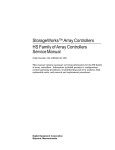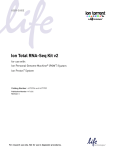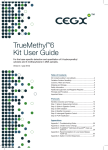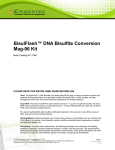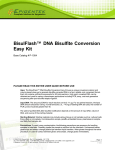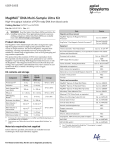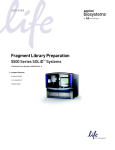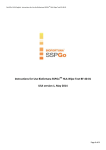Download Applied Biosystems SOLiD 4 System SOLiD Bisulfite
Transcript
Applied Biosystems SOLiD™ 4 System SOLiD™ Bisulfite-Converted Fragment Library Preparation Protocol Bisulfite-Converted Library Preparation Templated Bead Preparation Instrument Operation For Research Use Only. Not intended for any animal or human therapeutic or diagnostic use. This protocol is the proprietary material of Applied Biosystems, LLC or its affiliates and is protected by laws of copyright. The customer of the SOLiD™ System is hereby granted limited, non-exclusive rights to use this protocol solely for the purpose of operating the SOLiD™ System. Unauthorized copying, renting, modifying, or creating derivatives of this protocol is prohibited. Information in this document is subject to change without notice. APPLIED BIOSYSTEMS DISCLAIMS ALL WARRANTIES WITH RESPECT TO THIS DOCUMENT, EXPRESSED OR IMPLIED, INCLUDING BUT NOT LIMITED TO THOSE OF MERCHANTABILITY, FITNESS FOR A PARTICULAR PURPOSE, OR NON-INFRINGEMENT OF INTELLECTUAL PROPERTY TO THE FULLEST EXTENT ALLOWED BY LAW, IN NO EVENT SHALL APPLIED BIOSYSTEMS BE LIABLE, WHETHER IN CONTRACT, TORT, WARRANTY, OR UNDER ANY STATUTE OR ON ANY OTHER BASIS FOR SPECIAL, INCIDENTAL, INDIRECT, PUNITIVE, MULTIPLE OR CONSEQUENTIAL DAMAGES IN CONNECTION WITH OR ARISING FROM THIS DOCUMENT, INCLUDING BUT NOT LIMITED TO THE USE THEREOF, WHETHER OR NOT FORESEEABLE AND WHETHER OR NOT APPLIED BIOSYSTEMS IS ADVISED OF THE POSSIBILITY OF SUCH DAMAGES. TRADEMARKS: The trademarks mentioned herein are the property of Life Technologies Corporation or their respective owners. NanoDrop is a trademark of NanoDrop Technologies, LLC. Agentcourt and AMPure are trademarks of Beckman Coulter, Inc. Eppendorf is a trademark of Eppendorf AG. Covaris is a trademark of Covaris, Inc. TaqMan is a trademark of Roche Molecular Systems, Inc. © Copyright 2010, Life Technologies Corporation. All rights reserved. Part no. MAN0003271 Rev. date 2 December 2010 Table of Contents Required Materials.......................................................................................................................................4 Description of the Protocol .........................................................................................................................7 Methods ....................................................................................................................................................... 9 Before Starting ..............................................................................................................................................9 Step 1. Shear the DNA ...............................................................................................................................10 Optional: Spike-In Lambda DNA Digested with Alu I .........................................................................11 Step 2. Prepare the Special dNTP Mixes .................................................................................................12 Step 3. Prepare the Methyl-P1 Adaptor ..................................................................................................13 Step 4. End-Repair the DNA.....................................................................................................................15 Step 5. Purify the End-Repaired DNA ....................................................................................................16 Step 6. Ligate Methyl-P1 and P2 Adaptors to the DNA .......................................................................17 Step 7. Purify the Adaptor-Ligated DNA ...............................................................................................18 Step 8. Nick-Translate the DNA...............................................................................................................19 Step 9. Purify the Nick-Translated DNA ................................................................................................20 Step 10. Bisulfite Convert the DNA .........................................................................................................21 Step 11. Desulfonate and Purify the Converted DNA ..........................................................................23 Step 12. Amplify the DNA ........................................................................................................................25 Step 13. Purify the Amplified DNA.........................................................................................................27 Step 14. Size-Select the DNA ....................................................................................................................28 Step 15. Quantitate the Library.................................................................................................................30 Technical Support.......................................................................................................................................31 SOLiD™ Bisulfite-Converted Fragment Library Preparation Protocol 3 Required Materials Introduction This section identifies the kits, reagents, and equipment needed for this protocol. Vendor and catalog information are provided in the following tables. SOLiD™ Fragment Library Construction Kit The following components are needed from the SOLiD™ Fragment Library Construction Kit (Applied Biosystems 4443473). End polishing Enzyme 1 End polishing Enzyme 2 5X End-Polishing Buffer 5X T4 Ligase Buffer T4 Ligase Platinum® PCR Amplification Mix SOLiD™ Library Column Purification Kit with B2-S and B2-L buffers SOLiD™ Fragment Library Oligos Kit The following components are needed from the SOLiD™ Fragment Library Oligos Kit (Applied Biosystems 4401151). P2 adaptor, 50 μM Library PCR Primer 1 Library PCR Primer 2 SOLiD™ Library TaqMan® Quantitation Kit All components are needed from the SOLiD™ Library TaqMan® Quantitation Kit (Applied Biosystems 4449639) Invitrogen Reagents The following Invitrogen reagents are sold separately. Product Catalog no. UltraPure™ DNase/RNase-Free Distilled Water 10977-015 dATP, 100 mM 10216-018 dTTP, 100 mM 10219-012 dGTP, 100 mM 10218-014 E-Gel® EX Gels, 2% agarose G4010-02 ® E-Gel 50 bp DNA Ladder 10488-099 Optional if performing the lambda DNA spike-in: 4 Lambda DNA 25250-010 Alu I restriction enzyme 45200-029 PureLink™ PCR Purification Kit K3100-01 SOLiD™ Bisulfite-Converted Fragment Library Preparation Protocol Applied Biosystems Reagents The following Applied Biosystems reagents are sold separately. Product Catalog no. Exo– Klenow Fragment (5 U/μL) AM2006 0.5 M EDTA, pH 8.0 AM9260G Hi-Di™ Formamide 4440753 ™ Cells-to-CpG Bisulfite Conversion Kit (50 rxns) 4445249 8-strip PCR Tubes and Caps, RNase-free AM12230 Low TE buffer Additional Reagents 4389764 The following reagents from other vendors are sold separately. Product Vendor Catalog no. TriLink (USA) N-2026 Jena Bioscience (Germany) NU-1125 Amicon Ultra-0.5 10K devices Millipore UFC501024 Agencourt® AMPure® XP beads Beckman Coulter A63880 Eppendorf 022431021 Covaris™ microTUBEs™ (snap-cap) Covaris 520045 Isopropanol, 100% Various Various Ethanol, 100% Various Various DTT, molecular biology grade Various Various 5-methyl-dCTP, 100 mM Alternate source of 5-methyl-dCTP ® DNA LoBind Tubes, 1.5 mL P1 Adaptor Oligos The P1 adaptor oligos are two single-stranded oligos that are annealed together to make the double-stranded methyl-P1 adaptor. One of the adaptor oligos (P1A) is methylated; the other (P1B) is not. The oligos can be manufactured by any supplier capable of providing custom oligos containing 5-methyl-cytidine residues at ≥ 90% purity (typically HPLC purified). IDT (Coralville, Iowa, USA) is one such supplier. The sequences that should be ordered are: P1A Adaptor Oligo (top strand, 41 bp, 5-methyl-C denoted as “M” below): 5´- MMAMTAMGMMTMMGMTTTMMTMTMTATGGGMAGTMGGTGAT -3´ P1B Adaptor Oligo (bottom strand, 43 bp, unmethylated) 5´- ATCACCGACTGCCCATAGAGAGGAAAGCGGAGGCGTAGTGGTT -3´ SOLiD™ Bisulfite-Converted Fragment Library Preparation Protocol 5 Equipment The following equipment is required. Microcentrifuge (e.g., Eppendorf® 5417R tabletop microcentrifuge) Thermal Cycler (e.g., Applied Biosystems GeneAmp® PCR System 9700) NanoDrop® ND-1000 Spectrophotometer Covaris™ S2 ultrasonicator Agilent 2100 Bioanalyzer Vortexer TaqMan®-compatible qPCR instrument Magnetic rack (if using Agencourt® AMPure® XP Beads for size selection) E-Gel® iBase™ Power System E-Gel® Safe Imager™ Real-Time Transilluminator Heat block 6 SOLiD™ Bisulfite-Converted Fragment Library Preparation Protocol Description of the Protocol Protocol Overview This protocol provides detailed steps to prepare a bisulfite-converted fragment DNA library for sequencing using the SOLiD™ 4 System. Starting with 5 μg of purified human genomic DNA, the protocol can yield a library of sufficient complexity for genome-wide measurement of the cytosine methylation pattern at single-nucleotide resolution. This protocol uses products from Applied Biosystems, Invitrogen, and other vendors in a streamlined and validated workflow. Please refer to the SOLiD™ 4 System Library Preparation Guide, March 2010, pages 16–40 and associated Appendices for additional information on fragment library preparation. Workflow Summary Shear the DNA To begin, sonicate the input DNA into small fragments with a mean fragment size of 165 bp (range of 150–180 bp) using a Covaris™ S2 System. Conditions have been tested for shearing 5 μg DNA in a total volume of 100 μL. For certain DNA samples, optimizing the shearing protocol may be necessary. End-Repair the DNA Next, use End Polishing Enzyme 1 and End Polishing Enzyme 2 to convert DNA that has damaged or incompatible 5′-protruding and/or 3′-protruding ends to 5′phosphorylated, blunt-ended DNA. For bisulfite-compatible library construction, a dNTP mix lacking dCTP must be used. You can create such a mix by mixing dATP, dTTP, and dGTP each at a final concentration of 10 mM. Purify the DNA with the SOLiD™ Library Column Purification Kit PureLink™ columns are supplied with B2-S and B2-L buffers in the SOLiD™ Library Column Purification Kit. This kit is uniquely designed for SOLiD™ workflows and is used at different steps throughout this protocol. Ligate Methyl-P1 and P2 Adaptors to the DNA Next, ligate double-stranded P1 and P2 Adaptors to the ends of the end-repaired DNA. The non-methylated P2 adaptor is included in the SOLiD™ Fragment Library Oligos Kit. For bisulfite-compatible library construction, a modified P1 adaptor containing methylated cytosines must be annealed from high-purity single-stranded oligos purchased separately. After ligation, purify samples using the SOLiD™ Library Column Purification Kit. Nick-Translate the DNA After ligation, the library molecules undergo nick translation with a nucleotide mix that contains 5-methyl-dCTP in place of normal dCTP. This step yields bisulfite-compatible amplifiable library molecules. After nick translation, purify samples with the SOLiD™ Library Column Purification Kit. Bisulfite Conversion The Cells-to-CpG™ Bisulfite Conversion Kit is the preferred set of reagents to use for this step. Add Hi-Di™ Formamide to denature the DNA sample. The temperature and length of time for bisulfite conversion have been optimized to maximize the conversion efficiency and preserve library molecules. SOLiD™ Bisulfite-Converted Fragment Library Preparation Protocol 7 Desulfonation and Purification Desulfonate the library at room temperature within a centrifugal filtration device. Immediately afterward, the converted DNA is concentrated and exchanged into Low TE buffer within the same device. Amplify the Library Amplify the library molecules using at least four cycles of PCR. The bisulfite conversion process generates many uracil residues within the template DNA strands and also leaves the DNA largely single-stranded. Amplification replaces the uracil bases with thymidine bases and returns the library to a doublestranded state. Size-Select the DNA To preserve maximum sequence complexity, size-select the ligated, purified DNA to a broad distribution range (100–350 bp) with Agencourt® AMPure® XP beads. After bead-based sizing, the eluate can be directly quantified with the SOLiD™ Library TaqMan® Quantitation Kit. Quantitate the Library Using qPCR Quantitate the library using the SOLiD™ Library TaqMan® Quantitation Kit before proceeding to emulsion PCR. 8 SOLiD™ Bisulfite-Converted Fragment Library Preparation Protocol Methods Before Starting Tips and Notes • Start with 5 μg of DNA. Note: The amount of DNA loaded onto a PureLink™ column should be ≤5 μg to ensure maximum yield. If you want to experiment with larger amounts of starting material, be sure to split the sample over multiple PureLink™ columns during the purification steps. • Adjust microcentrifuge speeds and times according to the g-forces specified in the protocols. Applied Biosystems recommends the Eppendorf® 5417R tabletop microcentrifuge. • Prior to loading, dry spin all PureLink™ columns at 10,000 × g (13,000 rpm) for 1 minute. • Perform all steps requiring 0.5-mL and 1.5-mL tubes with Eppendorf® LoBind Tubes. • Thaw reagents on ice before use. SOLiD™ Bisulfite-Converted Fragment Library Preparation Protocol 9 Step 1. Shear the DNA Introduction Materials Needed In this step, you shear the DNA using the Covaris™ S2. Sonication conditions have been optimized for shearing the DNA into a mean fragment size of 165 bp (range of 150–180 bp). • Covaris™ S2 ultrasonicator • Covaris™ microTUBEs™ • LoBind tubes • Low TE Buffer • Set the chiller temperature on the Covaris™ S2 to 2–5°C to ensure that the temperature of the water bath is ~5°C. Higher temperatures during fragmentation can be detrimental. The circulated water chiller should be supplemented with 20% ethylene glycol. • To load and unload the Covaris™ microTUBE™ correctly from the microTUBE holder, see the Covaris™ S2 user manual. Shearing the DNA 1. Dilute the DNA to 100 μL in 1X Low TE Buffer in a LoBind tube, as follows: Table 1: DNA Dilution Component DNA 1X Low TE Buffer Total Volume 2. Place a Covaris™ microTUBE™ into the loading station on the Covaris™ S2. Keep the cap on the tube and use a tapered pipette tip to slowly transfer the 100 μL of DNA sample through the pre-split septa. Be careful not to introduce a bubble into the bottom of the tube. 3. Fill the Covaris™ S2 tank with fresh deionized water to level 12 on the graduated fill line label. The water should cover the visible glass part of the tube. 4. Shear the DNA using the following Covaris™ S2 System conditions: 5. 10 Amount 5 μg Variable 100 μL • Number of Cycles: 6 • Bath Temperature: 5°C • Bath Temperature Limit: 10°C • Mode: Frequency sweeping • Water Quality Testing Function: Off • Duty cycle: 10% • Intensity: 5 • Cycles/burst: 100 • Time: 60 seconds Remove the Covaris™ microTUBE™ from the loading station. While keeping the snap-cap on, insert a pipette tip through the pre-split septa, then slowly remove the sheared DNA. Transfer the sheared DNA into a new 1.5-mL LoBind tube. SOLiD™ Bisulfite-Converted Fragment Library Preparation Protocol Optional: Spike-In Lambda DNA Digested with Alu I Introduction Materials Needed In this optional step, you add endonuclease-digested phage lambda DNA to your sample as a control. • Whole lambda DNA • Alu I restriction enzyme • PureLink™ PCR Purification Kit • Low TE Buffer Purpose of the Lambda DNA The addition of endonuclease-digested phage lambda DNA is useful for monitoring the conversion efficiency of the bisulfite reaction. Lambda grown in dcm+ bacteria contains only a very small amount of cytidine methylation (on the internal cytosines of CCWGG motifs). Consequently, the frequency with which all other cytosines in lambda-derived sequences are converted to thymidine after treatment with bisulfite and subsequent amplification provides a good measure of the overall conversion efficiency within a complex sample. Digestion with an enzyme such as Alu I is convenient because it produces a large number of fragments with varying sequences that fall within a useful size for such monitoring. Furthermore, since Alu I is a blunt-cutter that cuts between G and C of the 5’…AGCT…3’ palindromic motif, the sequences coming from the lambda “spike” can be identified by their ability to be mapped to the lambda genome and by a characteristic CT (converts to “TT”) 5’ dinucleotide or AG 3’ dinucleotide. Creating and Adding the Lambda DNA Standard To create a lambda DNA standard: 1. Digest 50 μg of whole lambda DNA to completion with 100 units of Alu I enzyme in a 250 μl volume in an appropriate buffer at 37°C overnight. 2. Purify the digested DNA fragments with the PureLink™ PCR Purification Kit. 3. Measure the concentration of the purified DNA by spectrophotometry. 4. Dilute to a working stock concentration of 10 ng/μL with Low TE Buffer. 5. For every 1 μg of starting material, add 10 ng (1 μL) of Alu I-digested lambda DNA directly to the sheared genomic DNA from the previous page (e.g., add 50 ng of digested lambda DNA to 5 μg of sheared sample DNA). SOLiD™ Bisulfite-Converted Fragment Library Preparation Protocol 11 Step 2. Prepare the Special dNTP Mixes Introduction Materials Needed In this step, you prepare the two special dNTP mixes required to construct bisulfite-compatible SOLiD™ fragment libraries. • dATP, 100 mM • dTTP, 100 mM • dGTP, 100 mM • 5-methyl-dCTP, 100 mM (TriLink)* • 10 mM Tris-HCl (pH 7.5), nuclease-free • Nuclease-free water *Jena Bioscience (Germany) also supplies 5-methyl-dCTP but as a 10 mM stock solution (catalog no. NU-1125). If you want to use this more dilute stock, use 50 μL per 100 μL final volume and reduce the amount of nuclease-free water from 74 μL to 29 μL in the following protocol. dNTP Mix without dCTP Prepare a 100-μL volume of a dNTP mix without dCTP as follows. Store in sub-aliquots (8 μL needed per library) at –20ºC. Table 2: dNTP Mix without dCTP Component dATP, 100 mM stock dTTP, 100 mM stock dGTP, 100 mM stock 10 mM Tris-HCl (pH 7.5), nuclease-free Nuclease-free water Total Volume dNTP Mix with Methyl-dCTP Volume (μL) 10 10 10 6 64 100 Prepare a 100-μL volume of a dNTP mix with 5-methyl-dCTP in place of normal dCTP, as follows. Store in sub-aliquots (5 μL needed per library) at –20ºC. Table 3: dNTP Mix with Methyl dCTP Component dATP, 100 mM stock dTTP, 100 mM stock dGTP, 100 mM stock 5-methyl-2’-deoxycytidine -5’-triphosphate (5-methyl-dCTP) 100 mM stock (TriLink) 10 mM Tris-HCl (pH 7.5), nuclease-free Nuclease-free water Total Volume 12 Volume (μL) 5 5 5 5 6 74 100 SOLiD™ Bisulfite-Converted Fragment Library Preparation Protocol Step 3. Prepare the Methyl-P1 Adaptor Introduction Materials Needed In this step, you prepare a modified P1 adaptor that contains 5-methyl cytidine residues in place of normal non-methylated cytidine residues. • P1A adaptor oligo (methylated) • P1B adaptor oligo (unmethylated) • 5X T4 DNA Ligase Buffer • Low TE Buffer 5X T4 Ligase Buffer is used as an annealing buffer in the following procedure. P1 Adaptor Oligos The P1 adaptor oligos are two complementary single-stranded oligos that are annealed together to make the double-stranded methyl-P1 adaptor. The P1A adaptor oligo is methylated; P1B is not. The oligos can be manufactured by any supplier capable of providing custom oligos containing 5-methyl-cytidine residues at ≥ 90% purity (typically HPLC purified). IDT (Coralville, Iowa, USA) is one such supplier. The sequences that should be ordered are: P1A Adaptor Oligo (top strand, 41 bp, 5-methyl-C denoted as “M” below): 5´- MMAMTAMGMMTMMGMTTTMMTMTMTATGGGMAGTMGGTGAT -3´ P1B Adaptor Oligo (bottom strand, 43 bp, unmethylated) 5´- ATCACCGACTGCCCATAGAGAGGAAAGCGGAGGCGTAGTGGTT -3´ Annealing the Adaptor Oligos Anneal the adaptor oligos as follows: 1. Resuspend each P1 adaptor oligo to ~250 μM in Low TE Buffer. 2. The extinction coefficient of the methylated strand is 361,400 L/(mole-cm) and that of the non-methylated strand is 430,500 L/(mole-cm). Measure the exact concentration of the resuspended oligos by UV spectrophotometry 3. Dilute each oligo to a final concentration of 125 μM, and prepare a mixture of the oligo strands as follows. Table 4: Methyl-P1 Adaptor Annealing Mix Component P1A adaptor oligo, 125 μM P1B adaptor oligo, 125 μM 5X T4 Ligase Buffer Total Volume Volume (μL) 40 40 20 100 After annealing, the proportions above will yield a solution that contains double-stranded methyl-P1 adaptor at a concentration of 50 μM. Protocol continued on the next page SOLiD™ Bisulfite-Converted Fragment Library Preparation Protocol 13 Protocol continued from the previous page 4. In a thermal cycler such as the Applied Biosystems GeneAmp® PCR System 9700, heat the solution to 95ºC then controllably cool it as shown below to permit the complementary oligos to efficiently anneal into double-stranded adaptor molecules. Table 5: Cooling steps for annealing methylP1 adaptor in a thermal cycler Temperature (ºC) Time (minutes) 95 5 72 5 60 5 50 3 40 3 30 3 20 3 10 3 4 forever 5. 14 After annealing, the double-stranded methyl-P1 adaptor may be handled and stored alongside the P2 adaptor from the SOLiD™ Fragment Library Oligos Kit. As always, be careful to avoid denaturing the annealed adaptors; do not bring them above 37ºC. SOLiD™ Bisulfite-Converted Fragment Library Preparation Protocol Step 4. End-Repair the DNA Introduction In this step, you end-repair the sheared DNA. How End-Repair Works The 5′-to-3′ polymerase and the 3′-to-5′ exonuclease activities of End Polishing Enzyme 2 generate blunt-ended DNA fragments. End Polishing Enzyme 1 and ATP phosphorylate the 5′-ends of the blunt-ended DNA to enable subsequent ligation. Materials Needed • 5X End-Polishing Buffer • End-Polishing Enzyme 1, 10 U/μL • End-Polishing Enzyme 2, 5 U/μL • 1.5-mL LoBind tubes • Nuclease-free water End-Repair Mixture Combine and mix the following components in a 1.5-mL LoBind tube, and incubate at room temperature for 30 minutes. Table 6: End-Repair Mix Component Sheared DNA (5 μg) 5X End-Polishing Buffer dNTP mix without dCTP (from page 12) Nuclease-free Water End-Polishing Enzyme 1, 10 U/μL End-Polishing Enzyme 2, 5 U/μL Total Volume SOLiD™ Bisulfite-Converted Fragment Library Preparation Protocol Volume (μL) 100 40 8 32 4 16 200 15 Step 5. Purify the End-Repaired DNA Introduction Materials Needed In this step, you purify the end-repaired DNA using components in the SOLiD™ Library Column Purification Kit. • SOLiD™ Library Column Purification Kit (included with the SOLiD™ Fragment Library Construction Kit) The amount of DNA loaded onto a PureLink™ column should be ≤5 μg to ensure maximum yield. If you are experimenting with larger amounts of starting material, split the sample over multiple PureLink™ columns during the purification steps. Purification Procedure 1. Before loading the PureLink™ column, dry spin at 10,000 × g (13,000 rpm) for 1 minute. 2. Add 800 μL (four volumes) of Binding Buffer (B2-S) containing 55% isopropanol to the 200 μL of end-repaired DNA from the previous page. Mix thoroughly. 3. Apply ~700 μL of the DNA/binding buffer mixture to the column. 4. Let the column stand for 2 minutes at room temperature. 5. Centrifuge the column at ≥10,000 × g (13,000 rpm) for 1 minute and discard the flow-through. 6. Repeat steps 3–5 to load the rest of the sample onto the column. After discarding the flow-through, place the column back into the same collection tube. 7. Add 650 μL of Wash Buffer (W1) to the column. 8. Centrifuge the column at ≥10,000 × g (13,000 rpm) for 2 minutes, then discard the flow-through. Repeat to remove any residual wash buffer. 9. Air-dry the column for 2 minutes to evaporate any residual alcohol. Insert the column into a clean 1.5-mL LoBind tube. 10. Add 50 μL of Elution Buffer (E1) to the column to elute the DNA, then let the column stand for 2 minutes. 11. Centrifuge the column at ≥10,000 × g (13,000 rpm) for 1 minute. DO NOT DISCARD! The flow-through contains your sample. 12. Add the eluate back onto the column, then let the column stand for 2 minutes. Centrifuge the column once more at ≥10,000 × g (13,000 rpm) for 1 minute and collect the flow-through. 13. Quantitate the purified DNA by using 2 μL of the sample on the NanoDrop® ND-1000 Spectrophotometer. STOPPING POINT! Store the purified DNA in Elution Buffer (E1) at 4ºC or proceed directly to Ligate Methyl-P1 and P2 Adaptors to the DNA. 16 SOLiD™ Bisulfite-Converted Fragment Library Preparation Protocol Step 6. Ligate Methyl-P1 and P2 Adaptors to the DNA Introduction Materials Needed In this step, you ligate the methyl-P1 adaptor and non-methylated P2 adaptor to the DNA. • 5X T4 Ligase Buffer • T4 Ligase • Methyl-P1 adaptor (double-stranded, from page 13) • P2 Adaptor (double-stranded, included in the SOLiD™ Fragment Library Oligos Kit) • 1.5-mL LoBind tube • Nuclease-free water Calculating the Amount of Each Adaptor Needed Before proceeding, calculate the amount of each double-stranded adaptor needed based on the amount of the DNA from the previous purification procedure, using the formulas below. If DNA fragments were sheared as described on page 9, the average insert size should be approximately 165 bp (before adaptor ligation). Formulas: X pmol/μg DNA = 1 μg DNA × (106 pg/ 1 μg) × (1 pmol/660 pg) × (1/average insert size) Y μL of adaptor needed = # of μg DNA × (X pmol/1 μg DNA) × 15 × (1 μL adaptor needed/ 50 pmol) Example: For 1 μg of purified end-repaired DNA with an average insert size of 165 bp X pmol/μg DNA = 1 μg DNA × (106 pg/ 1 μg) × (1 pmol/660 pg) × (1/165) = 9.2 pmol/μg DNA Y μL adaptor needed = 1 μg DNA × (9.2 pmol/1 μg DNA) × 15 × (1 μL adaptor needed/50 pmol) = 2.76 μL adaptor needed Ligating the Adaptors Combine and mix the following components in a 1.5-mL LoBind tube, and incubate at room temperature for 15 minutes. Table 7: Ligation Mix Component Methyl-P1 Adaptor (ds), 50 pmol/μL P2 Adaptor (ds), 50 pmol/μL 5X T4 Ligase Buffer DNA Nuclease-free Water T4 Ligase, 5 U/μL Total SOLiD™ Bisulfite-Converted Fragment Library Preparation Protocol Volume (μL) Y Y 40 48–50 Variable 10 200 17 Step 7. Purify the Adaptor-Ligated DNA Introduction In this step, you purify the adaptor-ligated DNA using components in the SOLiD™ Library Column Purification Kit. Materials Needed SOLiD™ Library Column Purification Kit (included with the SOLiD™ Fragment Library Construction Kit) Purification Procedure 1. Before loading the PureLink™ column, dry spin at 10,000 × g (13,000 rpm) for 1 minute. 2. Add 800 μL (four volumes) of Binding Buffer (B2-L) containing 40% isopropanol to the 200 μL of adaptor-ligated DNA from the previous page. Mix thoroughly. 3. Apply ~700 μL of the DNA/binding buffer mixture to the column. 4. Let the column stand for 2 minutes at room temperature. 5. Centrifuge the column at ≥10,000 × g (13,000 rpm) for 1 minute and discard the flow-through. 6. Repeat steps 3–5 to load the rest of the sample onto the column. After discarding the flow-through, place the column back into the same collection tube. 7. Add 650 μL of Wash Buffer (W1) to the column. 8. Centrifuge the column at ≥10,000 × g (13,000 rpm) for 2 minutes, then discard the flow-through. Repeat to remove any residual wash buffer. 9. Air-dry the column for 2 minutes to evaporate any residual alcohol. Insert the column into a clean 1.5-mL LoBind tube. 10. Add 50 μL of Elution Buffer (E1) to the column to elute the DNA, then let the column stand for 2 minutes. 11. Centrifuge the column at ≥10,000 × g (13,000 rpm) for 1 minute. DO NOT DISCARD THE ELUATE! The flow-through contains your sample. 12. Add the eluate back onto the column, then let the column stand for 2 minutes. Centrifuge the column once more at ≥10,000 × g (13,000 rpm) for 1 minute and collect the flow-through. STOPPING POINT! Store the purified DNA in Elution Buffer (E1) at 4ºC or proceed directly to Nick-Translate the DNA. 18 SOLiD™ Bisulfite-Converted Fragment Library Preparation Protocol Step 8. Nick-Translate the DNA Introduction Materials Needed In this step, you nick-translate the DNA • Exo– Klenow Fragment, 5 U/μL (Applied Biosystems) • 10 mM DTT • Tris-HCl (pH 8.0) • MgCl2 • NaCl • 0.5 M EDTA, pH 8.0 • 1.5-mL LoBind tube • Nuclease-free water Prepare 10X Nick Translation Buffer Prepare a stock solution of 10X Nick-Translation Buffer (10 μL needed per reaction). Store at –20ºC. 500 mM Tris-HCl (pH 8.0) 100 mM MgCl2 500 mM NaCl Nick Translation Procedure 1. Combine and mix the following components in a 1.5-mL LoBind tube: Table 8: Nick Translation Mix Component DNA 10X Nick Translation Buffer (prepared as above) 10 mM DTT dNTP mix with methyl-dCTP (from page 12) Nuclease-free Water Exo– Klenow Fragment, 5 U/μL Total 2. Incubate at 16ºC for 1 hour. 3. Stop the reaction by adding 4 μL or 0.5 M EDTA, pH 8.0. SOLiD™ Bisulfite-Converted Fragment Library Preparation Protocol Volume (μL) 48–50 10 1 5 Variable 4 100 19 Step 9. Purify the Nick-Translated DNA Introduction Materials Needed Purification Procedure In this step, you purify the nick-translated DNA using components in the SOLiD™ Library Column Purification Kit. • SOLiD™ Library Column Purification Kit (included with the SOLiD™ Fragment Library Construction Kit) 1. Before loading the PureLink™ column, dry spin at 10,000 × g (13,000 rpm) for 1 minute. 2. Add 416 μL (four volumes) of Binding Buffer (B2-L) containing 40% isopropanol to the 104 μL of nick-translated DNA from the previous page. Mix thoroughly. 3. Apply the DNA/binding buffer mixture to a PureLink™ column. 4. Let the column stand for 2 minutes at room temperature. 5. Centrifuge the column at ≥10,000 × g (13,000 rpm) for 1 minute and discard the flow-through. Place the column back into the same collection tube. 6. Add 650 μL of Wash Buffer (W1) to the column. 7. Centrifuge the column at ≥10,000 × g (13,000 rpm) for 2 minutes, then discard the flow-through. Repeat to remove any residual wash buffer. 8. Air-dry the column for 2 minutes to evaporate any residual alcohol. Insert the column into a clean 1.5-mL LoBind tube. 9. Add 50 μL of Elution Buffer (E1) to the column to elute the DNA, then let the column stand for 2 minutes. 10. Centrifuge the column at ≥10,000 × g (13,000 rpm) for 1 minute. DO NOT DISCARD THE ELUATE! The eluate contains your sample. 11. Add the eluate back onto the column, then let the column stand for 2 minutes. Centrifuge the column once more at ≥10,000 × g (13,000 rpm) for 1 minute and collect the flow-through. 12. Quantitate the purified DNA by using 2 μL of the sample on the NanoDrop® ND-1000 Spectrophotometer. STOPPING POINT! Store the purified DNA in Elution Buffer (E1) at 4ºC or proceed directly to Bisulfite Convert the DNA. 20 SOLiD™ Bisulfite-Converted Fragment Library Preparation Protocol Step 10. Bisulfite Convert the DNA Introduction Materials Needed In this step, you use sodium bisulfite to chemically convert the cytosine bases in the DNA to uracil bases in an overnight reaction. Cytosines methylated at the 5 position are resistant to this chemical process, and remain as methylated Cs. Denaturation is promoted by adding Hi-Di™ Formamide to the DNA sample. • Cells-to-CpG™ Bisulfite Conversion Kit • Hi-Di™ Formamide • 1.5-mL LoBind tube • Nuclease-free water One Cells-to-CpG™ Bisulfite Conversion Kit provides enough conversion reagent (5 tubes) to convert 5 libraries. Preparing the Cells-to-CpG™ Conversion Reagent Prepare complete Cells-to-CpG™ Conversion Reagent immediately before use: 1. In a sterile 1.5-mL tube, mix 26 μL of Denaturation Reagent with 800 μL of nuclease-free water. 2. Add this mixture to one opaque brown tube of powdered Conversion Reagent and mix well by vortexing. Perform all subsequent steps in this opaque brown tube. 3. Add 50 μL of Conversion Buffer to the tube of resuspended Conversion Reagent, and mix again by vortexing. 4. Place the complete Conversion Reagent tube in a 60ºC water bath for 30 minutes. Remove and mix the tube every 10 minutes during incubation. 5. Following incubation, mix by vortexing 2–3 more times. Trace amounts of undissolved material may remain; this is normal. Keep the tube protected from light at room temperature until use. The following reaction requires an 8-hour (e.g., overnight) incubation, and can be held in the thermal cycler at 4ºC for several hours afterwards. SOLiD™ Bisulfite-Converted Fragment Library Preparation Protocol 21 Bisulfite Conversion Protocol 1. To each purified, nick-translated 50-μL DNA sample from page 20, add 50 μL of Hi-Di™ Formamide. 2. Mix thoroughly and heat the mixture at 95ºC for 5 minutes to denature the DNA. 3. Immediately place the DNA/formamide sample tube on ice for at least 2 minutes. 4. After cooling, split the 100 μL DNA/formamide sample into equal 25 μL subsamples in 4 PCR tubes. 5. Transfer the complete Conversion Reagent from its opaque brown tube (previous page) to a non-opaque 1.5-mL microcentrifuge tube. Pulse-spin the tube to force any undissolved material to the bottom of the tube. Note: 22 In the next step, be careful to pipet Conversion Reagent from the top of the tube to avoid transferring any undissolved solids from the bottom. 6. Add 125 μL of complete Conversion Reagent to each 25 μL DNA/formamide sample. Mix by pipetting up and down. 7. Place the tubes in a thermal cycler. Program the cycler to heat at 50ºC for 8 hours, then hold the reaction at 4ºC for up to 20 hours 8. Following incubation, proceed to Desulfonate and Purify the Converted DNA on the next page. SOLiD™ Bisulfite-Converted Fragment Library Preparation Protocol Step 11. Desulfonate and Purify the Converted DNA Introduction Materials Needed In this step, you desulfonate and purify the bisulfite-converted DNA. • Cells-to-CpG™ Bisulfite Conversion Kit • Amicon® Ultra-0.5 10K ultrafiltration device (Millipore) • Low TE Buffer • Nuclease-free water IMPORTANT! Dilute the stock Desulfonation Reagent provided in the Cells-to-CpG™ kit with nuclease-free water, NOT ethanol. Add 10 mL of nuclease-free water per bottle of stock Desulfonation Reagent. Dilution with water is required to maximize the yield of bisulfiteconverted library DNA by ultrafiltration-based purification. DO NOT use the water-diluted Desulfonation Reagent for any purpose other than the bisulfite conversion reaction in this protocol. Desulfonation in water is NOT compatible with the standard silica column-based purification described in the Cells-to-CpG™ kit manual. • When adding solutions to centrifugal filtration devices such as the Amicon® Ultra-0.5 10K, avoid touching the membranes as this can lead to device failure. • After the 8-hour conversion reaction, some discoloration (light yellow or brown) of the solution may be evident. The color goes away during the course of the desulfonation and purification steps, and has no apparent effect on the quality of the final library DNA. Desulfonation and Purification Protocol Desulfonate and purify each 150-μL bisulfite conversion reaction (sub-sample) separately using an Amicon® Ultra-0.5 10K ultrafiltration device. All steps are at room temperature 1. Dilute the stock Desulfonation Reagent provided in the Cells-to-CpG™ kit with nuclease-free water as described in the Important note above. 2. Add 200 μL of nuclease-free water to the Amicon® device, then add a 150-μL bisulfite-converted DNA sub-sample. 3. Spin at 14,000 × g for 10 minutes and measure the flow-through volume (should be ~300 μL). 4. Replace the flow-through with an equal volume of nuclease-free water added onto the column. 5. Repeat steps 3–4 one more time. 6. Spin at 14,000 × g for 10 minutes and measure the flow-through (~300 μL). 7. Replace the flow-through with an equal volume of diluted Desulfonation Reagent. 8. Mix well and then let stand for 15 minutes. Protocol continued on the next page SOLiD™ Bisulfite-Converted Fragment Library Preparation Protocol 23 Continued from the previous page 9. Spin at 14,000 × g for 10 minutes and measure the flow-through (~300 μL). 10. Replace the flow-through with an equal volume of nuclease-free water. 11. Spin at 14,000 × g for 10 minutes and measure the flow-through (~300 μL). 12. Replace the flow-through with an equal volume of Low TE Buffer. 13. Repeat steps 12–13 one more time. 14. Spin at 14,000 × g for 15 minutes and measure the flow-through. This time, ~350 μL should flow through. 15. Invert the device into a clean receiving tube and elute at 1000 × g for 1 minute; the volume that elutes should be between 20 and 40 μL. 16. Re-pool the four sub-samples of bisulfite-converted DNA into a 1.5-mL LoBind tube. 17. The eluted, re-pooled, bisulfite-converted, single-stranded DNA library is now ready for PCR amplification. 24 SOLiD™ Bisulfite-Converted Fragment Library Preparation Protocol Step 12. Amplify the DNA Introduction In this step, you amplify the bisulfite-converted DNA in a PCR reaction. The bisulfite conversion process generates many uracil residues within the template DNA strands and also leaves the DNA largely single-stranded. Amplification replaces the uracil bases with thymidine bases and returns the library to a double-stranded state. Materials Needed • Platinum® PCR Amplification Mix • Library PCR Primer 1 • Library PCR Primer 2 • Thermal cycler • E-Gel® EX 2% Gel • E-Gel® iBase™ Power System • E-Gel® Safe Imager™ Real-Time Transilluminator Determining the Optimal Number of PCR Cycles To avoid overamplification, determine the minimum number of PCR cycles needed to generate a visible smear of DNA on an agarose gel, as described below. 1. Prepare a test PCR reaction using 1/10th of the eluate from the previous page (typically 8–16 μL). Table 9: Test PCR Reaction Component Platinum® PCR Amplification Mix Library PCR Primer 1 Library PCR Primer 2 DNA library sample (eluate from previous page) 2. 38 1 1 8–16 μL Run the PCR program shown in Table 10. Cycle 4 times, then pause the reaction at 4ºC to remove 5 μL to run on a gel. Continue cycling, pausing at 4ºC every 2 cycles to withdraw another 5-μL sample, up to ~12 cycles. Place each sample in a separate LoBind tube. Table 10: Test PCR Cycling Program Stage Holding Cycling (collect sample at 4 cycles and at 2-cycle intervals thereafter up to ~12 cycles) Holding Holding 3. Volume μL Step Denature Denature Anneal Extend Extend Hold Temp (ºC) 95 95 62 70 70 4 Time 5 min 15 sec 15 sec 3 min 5 min ∞ Run the amplified samples on an E-Gel® EX 2% Gel with an E-Gel® iBase™ and E-Gel® Safe Imager™ Real-Time blue-light transilluminator. Determine the minimum number of cycles needed to generate a faintly visible smear of DNA. Usually this will be between 4 and 10 cycles. Then prepare and run the following full-scale reaction using that number of cycles. SOLiD™ Bisulfite-Converted Fragment Library Preparation Protocol 25 Amplification Reaction 1. Prepare a master mix based on the volume of eluate from page 24. The volumes below allow for one additional reaction for a no-template negative control: Table 11: PCR Master Mix Component Platinum® PCR Amplification Mix Library PCR Primer 1 Library PCR Primer 2 Total 2. Eluate > 100 μL Volume (μL) F = Volume of eluate/100 380 × F 10 × F 10 × F 400 × F Eluate ≤ 100 μL Volume μL 380 10 10 400 If the volume of the eluate is: • ≤ 100 μL, add 400 μL of master mix to the eluate, then distribute equally into four PCR reaction tubes. • > 100 μL, add 400 μL of master mix to every 100 μL of eluate, then distribute equally in 100–125 μL aliquots to multiple PCR reaction tubes. 3. Prepare and run the following PCR program, using the number of cycles determined previously. Table 12: PCR Cycling Program Stage Step Holding Denature Denature Cycling (number of Anneal cycles determined by Extend the previous test PCR) Holding Extend Holding Hold 4. 26 Temp (ºC) 95 95 62 70 70 4 Time 5 min 15 sec 15 sec 3 min 5 min ∞ After cycling, pool the reactions into 200–250 μL volumes in multiple 1.5-mL LoBind tubes. SOLiD™ Bisulfite-Converted Fragment Library Preparation Protocol Step 13. Purify the Amplified DNA Introduction Materials Needed Purification Procedure In this step, you purify the amplified DNA using components in the SOLiD™ Library Column Purification Kit. • SOLiD™ Library Column Purification Kit (included with the SOLiD™ Fragment Library Construction Kit) Perform the following workflow for each 200–250 μL pooled PCR volume from the previous page. 1. Before loading the PureLink™ columns, dry spin at 10,000 × g (13,000 rpm) for 1 minute. 2. Add four volumes of Binding Buffer (B2-L) containing 40% isopropanol to each 200–250 μL volume of amplified DNA from the previous page. Mix thoroughly. 3. For each sample, apply ~700 μL of the DNA/binding buffer mixture to a PureLink™ column. 4. Let the columns stand for 2 minutes at room temperature. 5. Centrifuge the columns at ≥10,000 × g (13,000 rpm) for 1 minute and discard the flow-through. 6. Repeat steps 3–5 to load the rest of each sample onto the column. Place the column back into the same collection tube. 7. Add 650 μL of Wash Buffer (W1) to each column. 8. Centrifuge the columns at ≥10,000 × g (13,000 rpm) for 2 minutes, then discard the flow-through. Repeat to remove any residual wash buffer. 9. Air-dry the columns for 2 minutes to evaporate any residual alcohol. Insert each column into a clean 1.5-mL LoBind tube. 10. Add 50 μL of Elution Buffer (E1) to each column to elute the DNA, then let the column stand for 2 minutes. 11. Centrifuge the columns at ≥10,000 × g (13,000 rpm) for 1 minute. DO NOT DISCARD THE ELUATE! The eluate contains your sample. 12. Add the eluate back onto each column, then let the columns stand for 2 minutes. Centrifuge the columns once more at ≥10,000 × g (13,000 rpm) for 1 minute and collect the flow-through. 13. Pool the eluted DNA from the PureLink™ columns into a LoBind tube. 14. Quantitate the purified DNA library by using 2 μL of the sample on the NanoDrop® ND-1000 Spectrophotometer. STOPPING POINT! Store the purified DNA in Elution Buffer (E1) at 4ºC or proceed directly to Size-Select the DNA. SOLiD™ Bisulfite-Converted Fragment Library Preparation Protocol 27 Step 14. Size-Select the DNA Introduction Materials Needed In this step, you size-select the DNA. • AMPure® XP Beads • 1.5-mL LoBind tubes • Magnetic rack • 70% ethanol, freshly prepared • Low TE Buffer Bead-Based Selection Using AMPure ® XP Beads This method selects for amplified adaptor-ligated DNA molecules that are between ~100 and ~350 bp in length, with an average length of~200 bp. 1. Add 0.8 volumes (relative to the volume of DNA solution) of Agencourt AMPure® XP beads to the sample. For example, if the pooled, eluted DNA from the previous page is in 100 μL, add 80 μL of bead solution. 2. Mix well and incubate the solution for 5 minutes at room temperature. 3. Place the tube of beads in a magnetic rack to separate the beads from the solution. Wait 2 minutes for the solution to clear before proceeding to the next step. 4. Keep the tube in place in the magnetic rack with the beads held against the tube wall and carefully remove and RETAIN the supernatant in a clean 1.5-mL LoBind tube. The supernatant contains your sample. 5. To this supernatant, add 1 volume (original volume) of Agencourt AMPure® XP beads (100 μL in the example from step 1 above). 6. Mix well and incubate the beads and DNA solution for 5 minutes at room temperature. 7. Place the tube of beads in a magnetic rack to separate the beads from the solution. Wait 2 minutes for the solution to clear before proceeding to the next step. 8. Keep the tube in place in the magnetic rack with the beads held against the tube wall and gently remove and DISCARD the supernatant. 9. With the tube still in place in the magnetic rack, gently add 200 μL of freshly prepared 70% ethanol. Keeping the tube in place on the magnet, let the bead pellet soak in the ethanol solution for 2 minutes at room temperature. Gently aspirate out and discard the ethanol solution. 10. Repeat this washing procedure twice with clean 70% ethanol each time. 11. Keeping the tube in place on the magnet, air-dry the beads (with the tube cap open) for 5 minutes at room temperature. 12. Elute the DNA by adding 22 μL of Low TE Buffer, vortexing for 10 seconds, pulse-spinning the solution to the bottom of the tube, and ensuring homogeneity by pipetting the solution up and down several times. Protocol continued on the next page 28 SOLiD™ Bisulfite-Converted Fragment Library Preparation Protocol Protocol continued from the previous page 13. Place the tube of beads in the magnetic rack to separate the beads from the solution. Wait 2 minutes for the solution to clear before proceeding to the next step. 14. Carefully transfer the supernatant to a new 1.5-mL LoBind tube. 15. Place the eluted sample again in the magnetic rack to separate any remaining beads from the solution. Wait for the solution to clear before proceeding to the next step. 16. Carefully transfer the supernatant to a new 1.5-mL LoBind tube. The library is now ready for quantitation. STOPPING POINT! Store the purified DNA at 4ºC or proceed directly to Quantitate the Library. SOLiD™ Bisulfite-Converted Fragment Library Preparation Protocol 29 Step 15. Quantitate the Library SOLiD™ Library TaqMan® Quantitation Kit For accurate library quantitation, quantitative PCR (qPCR) is strongly recommended. The SOLiD™ Library TaqMan® Quantitation Kit is available from Applied Biosystems. See the user manual for that kit for instructions. STOPPING POINT! Following quantitation, store the purified DNA at –20°C or proceed directly to emulsion PCR as described in the Applied Biosystems SOLiD™ 4 System Templated Bead Preparation Guide (PN 4448378) or the Applied Biosystems SOLiD™ EZ Bead™ Emulsifier Getting Started Guide (PN 4441486). 30 SOLiD™ Bisulfite-Converted Fragment Library Preparation Protocol Technical Support Support Information For the latest services and support information for all locations, go to: www.appliedbiosystems.com At the Applied Biosystems web site, you can: • Access worldwide telephone and fax numbers to contact Applied Biosystems Technical Support and Sales facilities. • Search through frequently asked questions (FAQs). • Submit a question directly to Technical Support. • Order Applied Biosystems user documents, SDSs, certificates of analysis, and other related documents. • Download PDF documents. • Obtain information about customer training. • Download software updates and patches. SOLiD™ Bisulfite-Converted Fragment Library Preparation Protocol 31 Part number: MAN0003271 Revision date: 2 December 2010 Headquarters 850 Lincoln Centre Drive | Foster City, CA 94404 USA Phone 650.638.5800 | Toll Free 800.345.5224 www.appliedbiosystems.com International Sales For our office locations please call the division headquarters or refer to our Web site at www.appliedbiosystems.com/about/offices.cfm

































